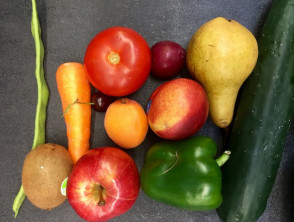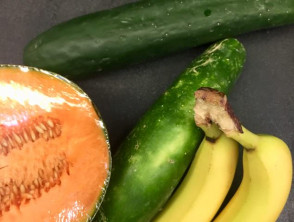What is pollen-food allergy syndrome?
Pollen-food allergy syndrome, previously known as oral allergy syndrome, presents with symptoms after eating specific raw foods that cross-react with an existing pollen allergy (pollinosis).
Who gets pollen-food allergy syndrome?
Pollen-food allergy syndrome (PFAS) affects people with allergic rhino-conjunctivitis (hay fever), atopic dermatitis, and/or asthma due to a pollen allergy. Any age group can develop pollen-food allergy syndrome once solid food is taken orally.
Pollen-food allergy syndrome is the most frequent food allergy in adults. It starts in pre-school children and increases steadily with age. The true prevalence is probably underestimated due to a failure to diagnose. A UK study reported an average prevalence of 2% (range 0.8–4.1%) in the general population.
The prevalence of pollen-food allergy syndrome and the foods involved vary between regions and pollen types. For example, in Sweden, 70% of those with birch-pollen allergy had PFAS whereas it affected only 19% of those with other pollen allergies. In Korea, PFAS is also more commonly associated with tree pollen allergy (48%) than grass pollen allergies (13%). PFAS is reported to affect approximately 50% of children in Britain and Korea with birch-pollen allergy, ranging from 17–36% of children under 5 years of age, up to 70% aged 10–18 years. A study from Sydney, Australia reported 12% of children (4–17 years of age) with rye grass allergy had PFAS most commonly due to watermelon.
Foods that cross-react with pollens
Birch pollen cross-reacts with many foods including:
- Rosaceae — apple, pear, sweet cherry, peach, plum, apricot, almond
- Other — Apiaceae (celery, carrot), Solanaceaea (potato), Actinidiaceae (kiwifruit), Betulaceae (hazelnut), Anacardiaceae (mango), chilli pepper.
Grass pollen can cross-react with:
- Cucurbitaceae — watermelon, melon
- Other — Solanaceae (tomato, potato), Actinidiaceae (kiwifruit), Rutaceae (orange), Fabaceae (peanut).
Ragweed pollen cross-reacts with:
- Cucurbitaceae — watermelon, melon, cantaloupe, zucchini, cucumber
- Musaceae (banana).
Mugwort pollen cross-reacts with:
- Apiaceae – celery, carrot
- Other – Anacardiaceae (mango), spices.
Foods that can cause pollen-food allergy syndrome
What causes pollen-food allergy syndrome?
Pollen-food allergy syndrome is caused by an immunoglobulin E (IgE)-mediated (type I hypersensitivity, ‘immediate’) immune reaction to specific proteins found in inhaled allergens (pollens), cross-reacting with plant-derived food proteins found in some raw fruits, vegetables, and nuts (class II food allergy). Cooking alters many (but not all) of these food proteins so most people do not develop symptoms to cooked fruit and vegetables. Exceptions include heat-stable proteins in celery, soybeans, and peanuts.
It is unclear why some people with pollen allergies develop PFAS while many do not.
What are the clinical features of pollen-food allergy syndrome?
Pollen-food allergy syndrome usually affects the lips, mouth, and pharynx (areas that directly contact the food), and less often causes systemic symptoms and signs either in association with oral symptoms or alone. Symptoms develop immediately or within 5–10 minutes of ingestion of the implicated food and usually resolve within 30 minutes. Symptoms may develop with several different foods due to food protein homology.
Oral
- Redness, swelling, itching of the lips, and oral mucosa
- Itch of the nose and ears
- Angioedema
- Oral red patches and blisters
- Difficulty swallowing
- Hoarse voice
- Tightness in the throat.
Systemic
- Skin: urticaria
- Gastrointestinal: nausea and vomiting, abdominal pain, diarrhoea
- Respiratory: cough, shortness of breath, wheeze, chest tightness or pain
- Low blood pressure
- Headache
- Dizziness.
What are the complications of pollen-food allergy syndrome?
Pollen-food allergy syndrome can rarely cause anaphylaxis (1–2%).
How is pollen-food allergy syndrome diagnosed?
Pollen-food allergy syndrome should be suspected clinically following a detailed history, and may be confirmed on testing.
- Skin prick testing or prick-by-prick testing: commercial food extracts are less sensitive than fresh or frozen fruit and vegetables.
- Serum IgE antibody measurements to pollens and food allergens.
- Oral food challenge test.
What is the differential diagnosis for pollen-food allergy syndrome?
- Food allergy — class I food allergens cause sensitisation through the gastrointestinal tract from a protein resistant to digestion. In contrast, PFAS is due to class II food allergens which result from prior sensitisation to pollens and cross-reactivity.
- Other food-related conditions such as coeliac disease and food intolerance
- Contact stomatitis/allergic contact cheilitis — type IV hypersensitivity reactions
What is the treatment for pollen-food allergy syndrome?
- Avoid trigger foods
- Cooking the trigger foods before eating: this is not effective for soybeans, celery, peanuts, and other nuts
- Accidental ingestion: rinsing mouth with water may help to reduce symptoms
- Pollen immunotherapy
- Subcutaneous immunotherapy to apples if relevant
- Self-injectable adrenaline (epinephrine) should be carried if there is a history of anaphylaxis.
What is the outcome for pollen-food allergy syndrome?
Pollen-food allergy syndrome has been reported to resolve in one-third of adult patients after completely avoiding the trigger foods for two years.


